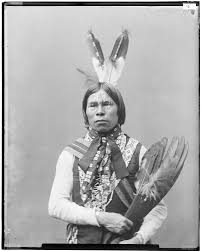Kickapoo people
The Kickapoo People (Kickapoo: Kiikaapoa or Kiikaapoi) are an Algonquian-speaking Native American and Indigenous Mexican tribe. Anishinaabeg say the name "Kickapoo" (Giiwigaabaw in the Anishinaabe language and its Kickapoo cognate Kiwikapawa) means "Stands here and there," which may have referred to the tribe's migratory patterns. The name can also mean "wanderer". This interpretation is contested and generally believed to be a folk etymology.
Today there are three federally recognized Kickapoo tribes in the United States: Kickapoo Tribe of Indians of the Kickapoo Reservation in Kansas, the Kickapoo Tribe of Oklahoma, and the Kickapoo Traditional Tribe of Texas. The Oklahoma and Texas bands are politically associated with each other. The Kickapoo in Kansas came from a relocation from southern Missouri in 1832 as a land exchange from their reserve there.Around 3,000 people are enrolled tribal members. Another band, the Tribu Kikapú, resides in Múzquiz Municipality in the Mexican state of Coahuila. Smaller bands live in Sonora and Durango.
The Kickapoo are an Algonquian-language people who likely migrated to or developed as a people in a large territory along the Wabash River in the area of modern Terre Haute, Indiana. They were confederated with the larger Wabash Confederacy, which included thePiankeshaw to their south, the Wea to their north, and the powerful Miami Tribe, to their east. A subgroup occupied the Upper Iowa Riverregion in what was later known as northeast Iowa and the Root River region in southeast Minnesota in the late 1600s and early 1700s. This group was probably known by the clan name "Mahouea", derived from the Illinoian word for wolf, m'hwea.
The earliest European contact with the Kickapoo tribe occurred during the La Salle Expeditions into Illinois Country in the late 17th century. The French colonists set up remote fur tradingposts throughout the region, including on the Wabash River. They typically would set up posts at or near Native American villages, and Terre Haute was founded as a French village. The Kickapoo had to contend with a changing cast of Europeans; the British defeated the French in the Seven Years' War and took over nominal rule of this area after 1763. They increased their own trading with the Kickapoo.
The United States acquired this territory east of the Mississippi River and north of the Ohio River after it gained independence from the United Kingdom. As white settlers moved into the region from the United States eastern areas, beginning in the early 19th century, the Kickapoo were under pressure. They negotiated with the United States over their territory in several treaties, including the Treaty of Vincennes, the Treaty of Grouseland, and the Treaty of Fort Wayne. They sold most of their lands to the United States and moved north to settle among the Wea.
Rising tensions between the regional tribes and the United States led to Tecumseh's War in 1811. The Kickapoo were one of Tecumseh's closest allies. Many Kickapoo warriors participated in the Battle of Tippecanoe and the subsequent War of 1812 on the side of the British, hoping to expel the American settlers from the region. A prominent, nonviolent spiritual leader among the Kickapoo was Kennekuk, who led his followers during Indian Removal in the 1830s to their current tribal lands in Kansas. He died there in 1852.
The close of the war led to a change of federal Indian policy in the Indiana Territory, and later the state of Indiana. American leaders began to advocate the removal of tribes to lands west of the Mississippi River, to extinguish their claims to lands wanted by American settlers. The Kickapoo were among the first tribes to leave Indiana under this program. They accepted land in Kansas and an annual subsidy in exchange for leaving the state.
Language
Kickapoo speak an Algonquian language closely related to that of the Sauk and Fox. They are classified with the Central Algonquians, and are also related to the Illinois Confederation.
In 1985 the Kickapoo Nation's School in Horton, Kansas, began a language immersion program for elementary school grades to revive teaching and use of the Kickapoo language in grades K-6. Efforts in language education continue at most Kickapoo sites. In 2010, the Head Start Program at the Kickapoo Traditional Tribe of Texas (KTTT) reservation, which teaches the Kickapoo language, became "the first Native American school to earn Texas School Ready! (TSR) Project certification."
Also in 2010, Mexico's "Instituto Nacional de Antropología e Historia (INAH) participated in the elaboration of a Kickapoo alphabet that may be used by more than 700 members of the group that dwell in Mexico and the United States, in the states of Coahuila and Texas. Previously no Kickapoo alphabet was used in Mexico; although there is a syllabic writing system it has no element ordination, organization or classification method." The Kickapoo in Mexico are known for their whistled speech.
Texts, recordings, and a vocabulary of the language are available.
The Kickapoo language and members of the Kickapoo tribe were featured in the movie The Only Good Indian (2009), directed by Greg Wilmott and starring Wes Studi. This was a fictionalized account of Native American children forced to attend an Indian boarding school, where they were forced to speak English and give up their cultures.
Inscrivez-vous au site
Soyez prévenu par email des prochaines mises à jour
Rejoignez les 75 autres membres

